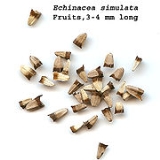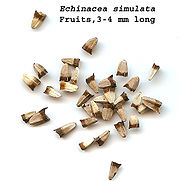
Echinacea simulata
Encyclopedia

Asteraceae
The Asteraceae or Compositae , is an exceedingly large and widespread family of vascular plants. The group has more than 22,750 currently accepted species, spread across 1620 genera and 12 subfamilies...
very much like Echinacea pallida
Echinacea pallida
Echinacea pallida , commonly called Pale Purple Cone-flower, is a species of herbaceous perennial plant in the family Asteraceae. It is sometimes grown in gardens and used for medicinal purposes. Its native range is the south central region of the United States.-Description:E. pallida is similar to E...
except that it has yellow colored pollen grains. Plants growing 50 to 100 cm tall from taproot
Taproot
A taproot is an enlarged, somewhat straight to tapering plant root that grows vertically downward. It forms a center from which other roots sprout laterally.Plants with taproots are difficult to transplant...
like roots fusiform in shape and branched. The foliage and stem
Plant stem
A stem is one of two main structural axes of a vascular plant. The stem is normally divided into nodes and internodes, the nodes hold buds which grow into one or more leaves, inflorescence , conifer cones, roots, other stems etc. The internodes distance one node from another...
s with spreading hairs sparsely to densely distributed. The stems are mostly green or purple mottled. The basal leaves with petiole
Petiole (botany)
In botany, the petiole is the stalk attaching the leaf blade to the stem. The petiole usually has the same internal structure as the stem. Outgrowths appearing on each side of the petiole are called stipules. Leaves lacking a petiole are called sessile, or clasping when they partly surround the...
s 4–20 cm long and the blades 3 or 5-nerved some leaves with 1 nerve, linear to lanceolate in shape and 5–40 cm long and 0.5–4 cm wide. The leaf bases tapering gradually with leaves having entire margins, usually with ciliate hairs. Normally single flower heads produced on peduncles 20–40+ cm long. Phyllaries or brachs below the flower heads lanceolate to ovate in shape, 7–15 mm wide and 1.5–3.5 mm long. The flowers with paleae 10–14 mm long with pinkish to purple colored tips, incurved and sharp-pointed. Ray corollas normally soft rose to pink colored but also rarely off white. The laminae drooping to reflexed, 40–90 long and 4–7 mm wide, without hairs or sparsely hairy on the undersides. The flower heads conic to hemispheric in shape 20–30 wide and 20–30 mm tall with Disc corollas 5–6.5 mm long, lobes pink to purplish. The seeds are produced in angled fruits called Cypselae that are tan in color and 3–4.5 mm long, with smooth surfaces, normally without hairs. One seed is produced per fruit and the seeds are rounded in shape and gray-tan in color.
Native from the eastern central states of the United States including Arkansas, Georgia, Illinois, Kansas, Missouri and Tennessee were it is found growing in rocky soils on open to wooded hillsides and prairies. Blooming in late spring to midsummer with some blooming into late summer, in the fall goldfinches feed on the seeds they remove from the dried cones.
In the past this species was grouped in with other Echinacea species.
Echinacea speciosa McGregor, Trans. Kansas Acad. Sci. 70: 366. 1967, not (Wenderoth) Paxton 1849; Echinacea pallida (Nuttall) Nuttall var. simulata (McGregor) Binns, B. R. Baum & Arnason

